Dada Harir Vav or Dhai Harir stepwell is a classic example of the Indo-Islamic architecture of 15th century. The sandstone construction carries the legacy of Solanki architecture. But the various parts of constructions and artwork also carries amazing Islamic influence.
In ancient and medieval times, rulers of the western region of India had constructed various stepwells. The primary reason of such stepweels were to preserve water; especially in the arid areas of Rajasthan and Gujarat in India. According to the reports, there are more than 120 stepwells still appear in Gujarat itself. But, Dhai Harir Stepwell, for its architectural beauty, is counted among the top stepwell architectures ever constructed in India.
More than 15 stepwells are presently visible in Ahmedabad adjascent area. Adalaj stepwell is another promient stepwell showcasing its beautiful architecture in the region.
Origination of name
Stepwells have many distinctive names with respect to different languages and locations. Gujarati speakers name it Vav or Vaav. So does the Marwari speakers of different parts of Rajasthan, Haryana and Gujarat. Rajasthani speakers name it as Bavadi or Bawri. In Maharashtra, the Marathi speakers call it Barav. Other Hindi speakers call it Bauli.
The name ‘Dada Harir Stepwell’ arrived from the founder, Dhai Harir, a houseold lady of Sultan Begada of Gujarat Sultanate. The lady superintendent of royal harem was known as Dhai Harir Sultani alias, Bai Harir Sultani. Hence the stepwell is also called Dhai Harir or Bai Harir Stepwell. Later, the name ‘Dhai Harir’ transformed to ‘Dada Harir’ with time.
Gujarati speakers, therefore call the stepwell Bai Harir ni Vav alias, Dhai Harir ni Vav or, Dada Harir ni Vav.
Dada Harir Ni Vav History
Dada Harir Stepwell history dates back to the late 15th century. Historical evidences appear from one Persian and one Sanskrit inscription still exsting at the stepwell. Dada Harir Stepwell Persian inscription mentions that Bai Harir Sultani had founded the stepwell in 1485 CE. She was the lady in-charge of royal harem.
Bai Harir Sultani, also known as Dhai Harir, was the household lady of Sultan Mahmud Begada of Gujarat Sultanate. She would supervise the royal harem of the royal palace.
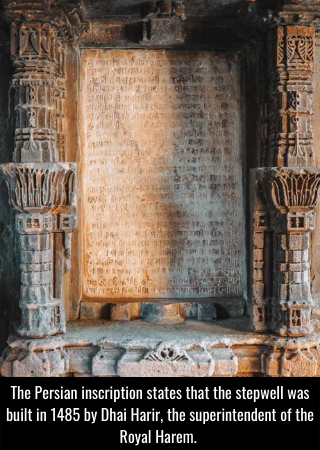
A publish in DNA India states, it cost about 3,29,000 Mahmudis (~Rs. 1 lakh on that period). Bai Harir Sultani had funded the entire money for the stepwell construction.
Dada Harir Stepwell Sanskrit inscription, however, states that the stepwell was built in 1499 CE. But, the Sanskrit inscription does not differ any statement on the Stepwell founder Bai Harir Sultani.
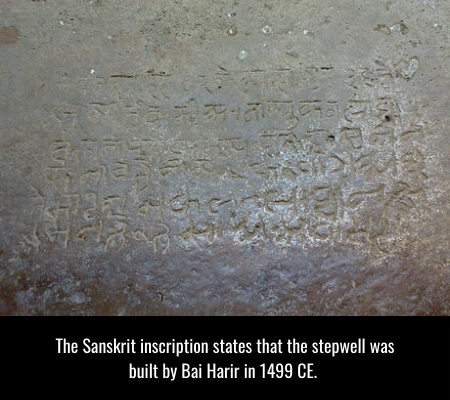
Dada Harir Vav architecture
Solanki architecture is massively visible in various parts of Gujarat and Rajasthan. Dada Harir ni Vav is remarkably carrying the legacy of ancient Solanki architecture. The main stepwell internally connects to the porch which is a clear indication of that. Further, the artwork especially on the pillars are definitely influenced from that. Internal artworks carries beautiful carvings of several Hindu and Jain gods and goddesses, elephants etc.
Several floral artworks of Islamic style also beautifully mixes to carvings of Hindu and Jain gods. Also the construction of the mosque and the domes of the other structures definitely are of Islamic style.

The full structure consists of five major parts- the domed porch at the entrance, the galleries, staircases, the principal well and another well for irrigation. Built on an eart to west axis, Bai Harir Stepwell entrance appears at the east and the well for irrigation at the extreme west.
The principal well is an octagonal structure with five floors. Each floor has eight columns. Further, the railings connecting the columns form the octagonal shape of Bai Harir Vav. Red sandstone columns and railings consist of intricate carvings. Specious floor design would allow enough people to gather and collect water from the well.
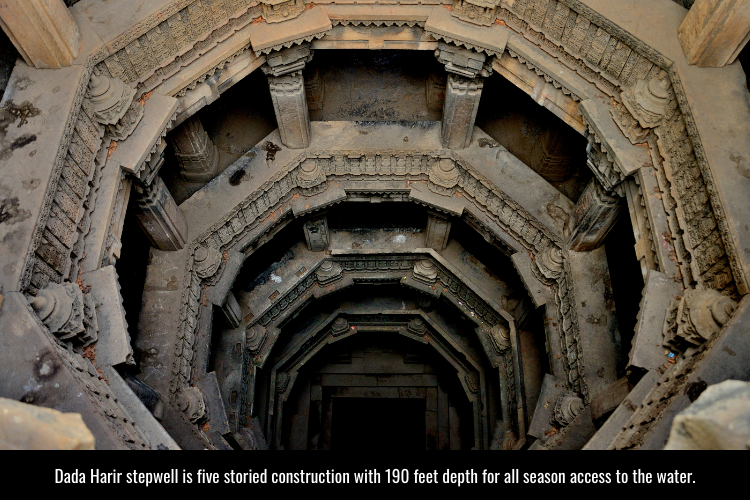
Bai Harir Stepwell has a depth of 190 feet and also is 40 feet wide. Spiral stairs would give access to the lowest level of water durring drier seasons.
There are 3 different galleries in 3 different levels. The top gallery of Bai Harir Stepwell is just 8 steps down starting from the entrance gate. Another 9 steps downwards will lead to the 2nd gallery. Third or the lowest gallery is further 8 steps down.
Bai Harir Sultani mosque and tomb
A small mosque appears in the stepwell area, built by Bai Harir Sultani. Some remarkable carvings in Islamic style is visible inside the tomb. Dada Harir Stepwell also houses the tomb of Dhai Harir, kept inside the mosque. Four other tombs are also kept along with Dai Harir tomb.
Dada Harir Stepwell entry fee and timings
Archaeological Survey of India (ASI) manages the site of Dada Harir Stepwell. However, ASI doesn’t charges any entry fees to the visitors.
Bai Harir Ni Vav is open all seven days of a week. It open at 9:00 AM in the morning and closes at 5:00 PM in the evening. There is no restriction in terms of photograpgy inside the stepwell premise.
How to reach Dada Hari Ni Vav?
Ahmedabad is the nearest city to the Dada Hari Stepwell. It just takes 15 minutes drive (8 kilometers) from Sardar Ballavbhai Patel of Ahmedabad. But Ahmedabad Railway Station is even more close to the stepwell, just 2 kilometers.
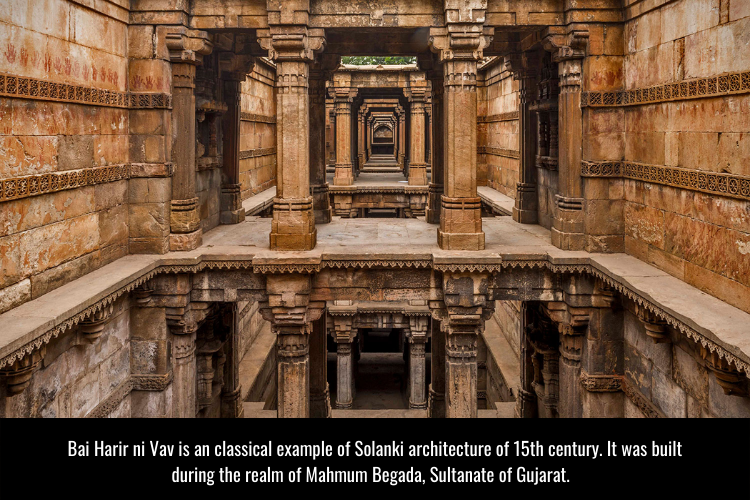
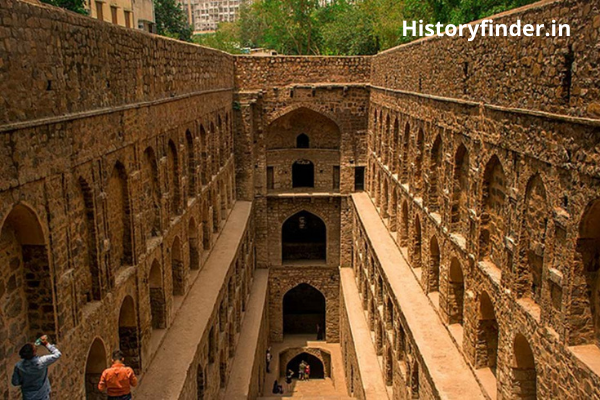
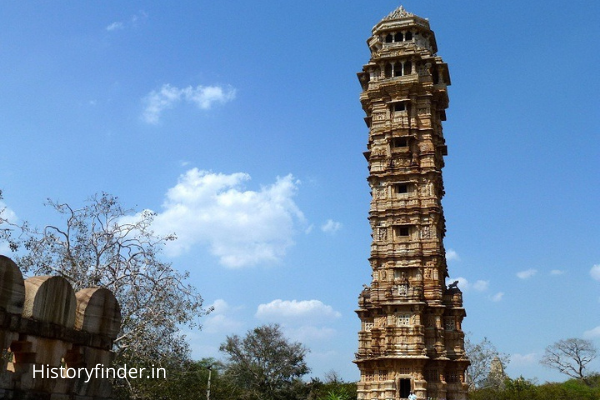

Pingback: Adalaj ni Vav: A 15th century stepwell in Ahmedabad -
Pingback: Adalaj stepwell history -